FNR Field Reports: Mallory Wagner Offers Week 3 Update from Sweden Study Abroad Trip
Throughout the 2024 Sustainable Natural Resources study abroad course in Sweden, FNR students will check in to provide weekly updates on the trip highlights. Junior aquatic sciences major Mallory Wagner takes the reins on Week 3,sharing about stops in Lysekil, Sweden and Oslo and Orebro, Norway. Wagner has a fisheries concentration as well as minors in communication and digital natural resources. The Chicago native is the outreach officer for the Purdue student chapter of the American Fisheries Society and is a member of Phi Sigma Rho sorority.
students will check in to provide weekly updates on the trip highlights. Junior aquatic sciences major Mallory Wagner takes the reins on Week 3,sharing about stops in Lysekil, Sweden and Oslo and Orebro, Norway. Wagner has a fisheries concentration as well as minors in communication and digital natural resources. The Chicago native is the outreach officer for the Purdue student chapter of the American Fisheries Society and is a member of Phi Sigma Rho sorority.
During the four-week Sustainable Natural Resources study abroad course students will examine natural resources broadly defined, including forestry, fisheries, wildlife, agriculture, mining, outdoor recreation, and urban sustainability. They will define, discover, and document examples where sustainability of resource use matters. The course explores the effect of terrain, climate, vegetation, faunal assemblages, social structures and technologies on natural resource use. FNR 46000 is a collaboration of Purdue University, North Carolina State University, and the Swedish University of Agricultural Sciences. American and Swedish students work together to research issues in resource management.
The course is co-taught by FNR's Drs. Tomas Hook and Doug Jacobs as well as other instructors from NC State and SLU.
July 15, 2024 - Monday
We started our day at the Havets Hus Aquarium in Lysekil, Sweden. The aquarium had exhibits with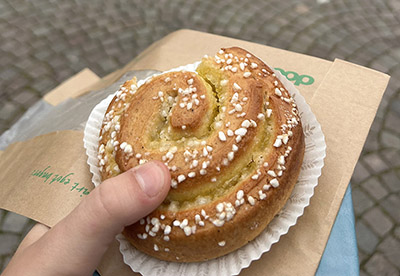 marine life from Swedish waters and showcased incredible examples of biodiversity and adaptations of aquatic organisms despite the cold water temperatures in this area. After the aquarium, we took a short break for lunch, and I took some time to explore the many shops and sights here in Lysekil. I particularly enjoyed visiting the Lysekils Kyrka, a beautiful cathedral located at the heart of the city, and of course a Swedish ‘Fika’ (AKA a delicious pastry) from a local bakery.
marine life from Swedish waters and showcased incredible examples of biodiversity and adaptations of aquatic organisms despite the cold water temperatures in this area. After the aquarium, we took a short break for lunch, and I took some time to explore the many shops and sights here in Lysekil. I particularly enjoyed visiting the Lysekils Kyrka, a beautiful cathedral located at the heart of the city, and of course a Swedish ‘Fika’ (AKA a delicious pastry) from a local bakery.
After our lunch break, we took a boat tour out on the North Sea where we were lucky enough to see tons of seals perched on the rocky islands throughout the bay. The weather was a little chilly and rainy, but seeing the water, wildlife, and scenery made the rough weather totally worth it.
Lastly, we took a walk to the Stångehuvuds naturreservat, an absolutely breathtaking nature reserve with granite cliffs carved by ice and glaciers years ago. Between WWI and WWII, the red granite was mined and shipped to several countries; in turn, the mining activity provided countless job opportunities for people all over Sweden. Mining ceased on the cliffs roughly 50 years ago, and in 1982, the area was officially designated as a nature reserve.
I don’t think words can be used to describe how stunning the sights were. The water, cliffs, rock formations, and native plants were unlike anything I have ever seen. I spent hours exploring the reserve and letting myself slow down and enjoy nature.
 A collage of images from Week 3 of the Sweden Study Abroad trip, including stops at Havets Hus Aquarium, Lysekils Kyrka and Stångehuvuds naturreservat in Lysekil.
A collage of images from Week 3 of the Sweden Study Abroad trip, including stops at Havets Hus Aquarium, Lysekils Kyrka and Stångehuvuds naturreservat in Lysekil. 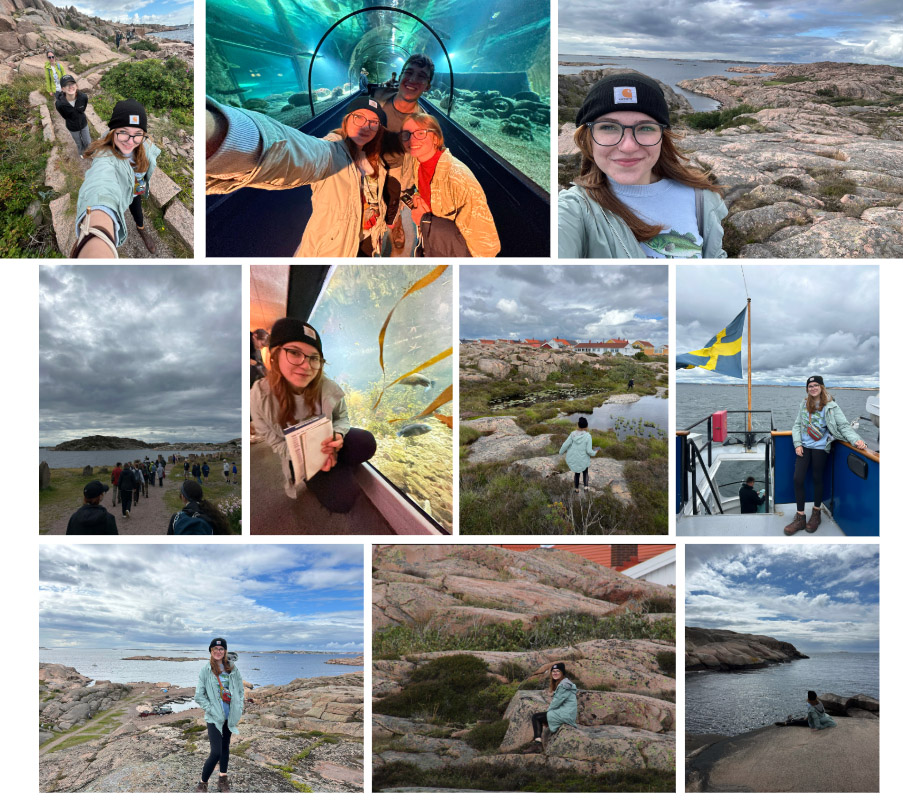 A collage of images from Week 3 of the Sweden Study Abroad trip, including stops at Havats Hus Aquarium, Lysekils Kyrka and Stångehuvuds naturreservat in Lysekil.
A collage of images from Week 3 of the Sweden Study Abroad trip, including stops at Havats Hus Aquarium, Lysekils Kyrka and Stångehuvuds naturreservat in Lysekil. July 16, 2024 - Tuesday
This morning we took a walk from our hotel to a local vineyard - the Luna Cafe and Vineyard. We were greeted by a lovely manager who was extremely knowledgeable about the history of the vineyard and the process of growing the grapes and turning them into wine. We learned about the challenges that come with growing grapes in the cold Swedish climate, and what varieties of grapes would be most likely to thrive in Sweden. At the vineyard we tried a delicious cocktail and some snacks to go with it before heading to our next stop of the day.
We then hopped on a bus and made our way to SLU’s Marine Research Center, where we had the opportunity to hear from a researcher at the University. There, we learned about cod stocks in the North Sea and their dwindling population status due to years of overfishing, as well as the efforts Sweden and Norway were making to expand wind power out in the open ocean.
I spent the rest of the evening exploring the town and the beautiful coastline; I was even able to find a few pieces of sea glass!
 A collage of images from the Sweden Study Abroad trip, including stops at the Luna Cafe and Vineyard and the SLU Marine Research Center.
A collage of images from the Sweden Study Abroad trip, including stops at the Luna Cafe and Vineyard and the SLU Marine Research Center. July 17, 2024 - Wednesday
We took a train today from Lysekil, Sweden to Oslo, Norway - one of our destinations I have been looking forward to the most! I have always dreamed of visiting Norway!
I loved watching out the window during our train ride, the lakes, forests, and cute little cities we passed through were gorgeous. When we got to Oslo, we checked into our hostel and I decided to go out on a walk through the city with a few friends. We checked out a few shops, saw a couple iconic sites like the Oslo Domkirke, opera house, and a few city parks, and even stopped at a local ice cream shop for a well-deserved soft-serve ice cream cone.
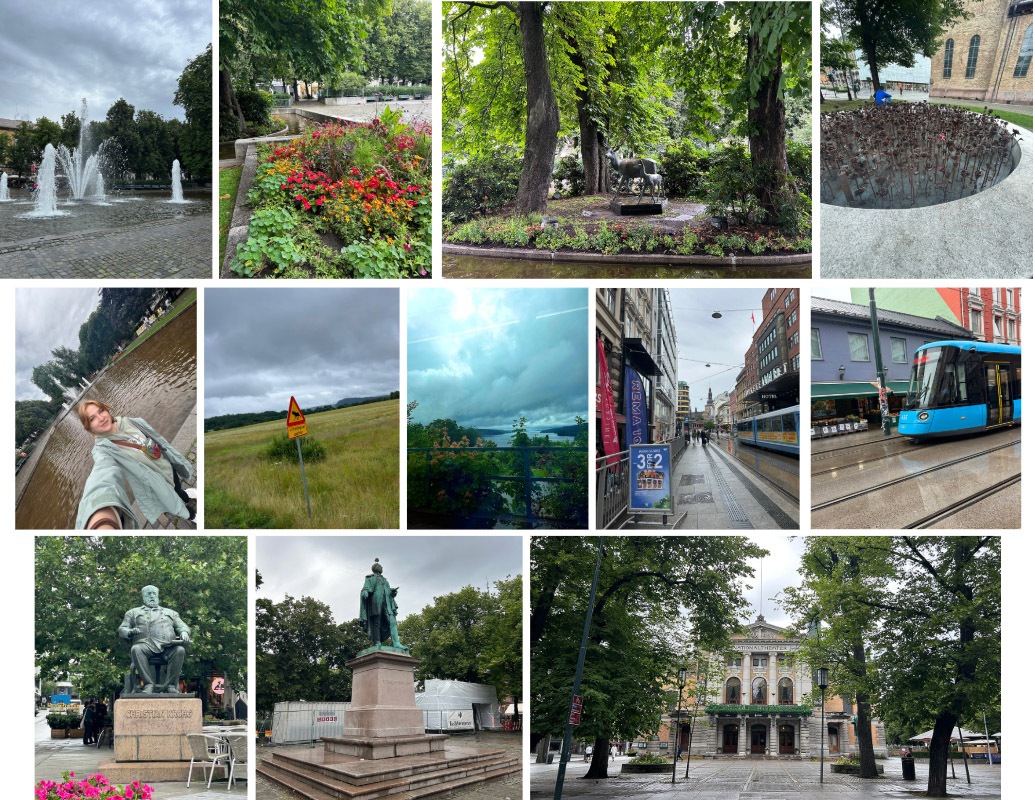 A collage of images from the Sweden Study Abroad trip, including a train ride from Lysekil, Sweden, to Oslo, Norway, as well as visits to the Oslo Domkirke, opera house, parks and local ice cream shop
A collage of images from the Sweden Study Abroad trip, including a train ride from Lysekil, Sweden, to Oslo, Norway, as well as visits to the Oslo Domkirke, opera house, parks and local ice cream shop July 18, 2024 - Thursday
This morning, we walked from our hostel in Oslo to the Natural History Museum not too far away. The main exhibit we went to experience was the Climate House exhibit, which featured installations relating to climate change and its effects. One thing I have noticed since staying here is that Norway prides itself on its sustainability features and has made huge impacts on the global standards for sustainability and reaching a point of net-zero carbon emissions. While at the Natural History Museum, we also had the chance to explore archaeology, geology, and botany exhibits that were absolutely incredible! Everything was so informative and well organized, and overall extremely enjoyable.
After the Natural History Museum, we took a brief break for lunch before hopping on a ferry to the Norwegian Maritime Museum where we learned all about boats, ships, and sailing throughout Norway’s history. I thought it was extremely interesting to learn about the history of ships from the Viking age all the way up until the modern day- it really helped to put into perspective just how far technology has come in terms of sailing and ocean travel.
 A collage of images from the Sweden Study Abroad trip, including stops at the Oslo National History Museum and the Norwegian Maritime Museum.
A collage of images from the Sweden Study Abroad trip, including stops at the Oslo National History Museum and the Norwegian Maritime Museum. July 19, 2024 - Friday
Today was our last full day in Oslo! We started the day at 9:30 a.m. and walked over to Oslo Central Station to meet with our tour guide for the day. From there, we walked around several different areas of Oslo, ranging from the newest constructions of the city like the Opera house and library to the oldest parks and buildings. We discussed different approaches to sustainability the city has taken over the years, and how Norway as a country strives to be as sustainable as possible. One thing we saw that I found fascinating was the Future Library located inside the largest library in Oslo. Started in 2014, a forest of trees was planted and will be harvested in 100 years to print 100 books. It acts as a sort of time capsule for books- each year an author puts a manuscript into the future library that will be opened in 100 years - however, nobody, not even the author of the books themselves, has access to the manuscripts. It serves as a reminder to promote a sustainable future for generations to come.
After our tour, we had the rest of the day free to explore the city. I had a quick lunch and went for a walk around a few of the gorgeous parks Oslo has to offer. I then met up with a few friends and checked out some second-hand and thrift stores in the area - I love buying second hand clothing because it reduces textile waste, and helps me to find more unique items you can’t find in every store! I wrapped up the day with dinner at a local pizza place and spent the rest of the evening relaxing while hanging out with friends.
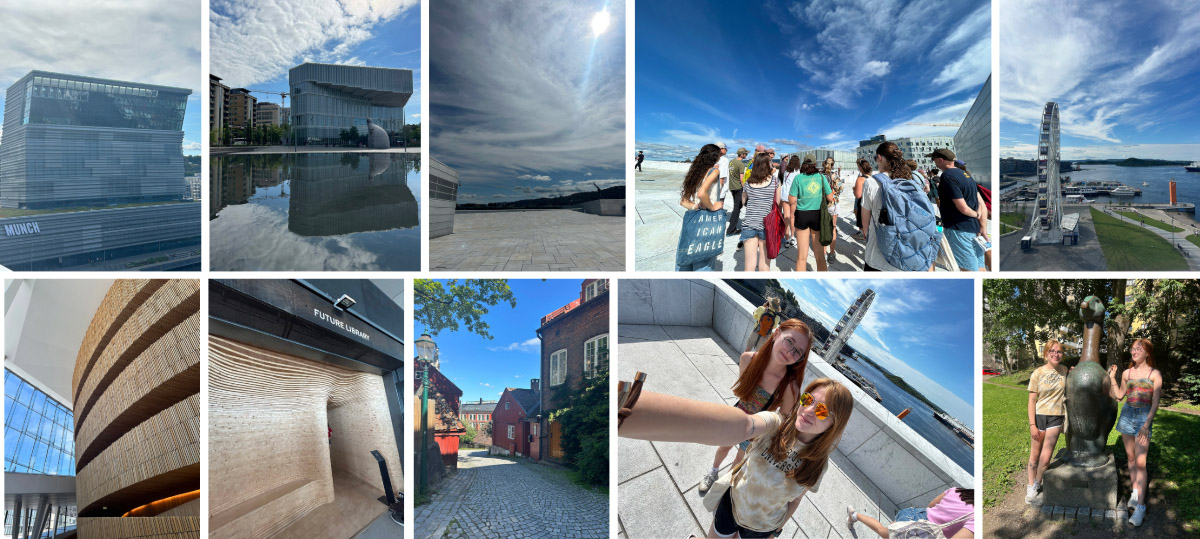 A collage of images from the Sweden Study Abroad trip, including the Oslo opera house, the largest library in Oslo and other sites around the city.
A collage of images from the Sweden Study Abroad trip, including the Oslo opera house, the largest library in Oslo and other sites around the city. July 20, 2024 - Saturday
Today was another travel day. We walked from our hostel in Oslo to the central station, where we caught our first train of the day. The journey was about 3.5 hours until we got to our connecting train, which was another 30 minutes. After 2 trains and a few unexpected events later, we made it to our second-to-last city: Orebro. After checking into our hostel and getting situated, I grabbed dinner and a few groceries for the next few days at the local supermarket before playing a heated game of soccer with some other students and Dr. Hook! I also walked around the city a bit and visited the Orebro Cathedral and the Orebro Castle - the sunset was absolutely gorgeous!
One thing I have been really impressed by on this trip is how simple it is to use public transportation. Every train, tram, and bus that we’ve been on has been simple to navigate and made for a quick and easy way to travel. Not to mention using public transportation also reduces carbon emissions!
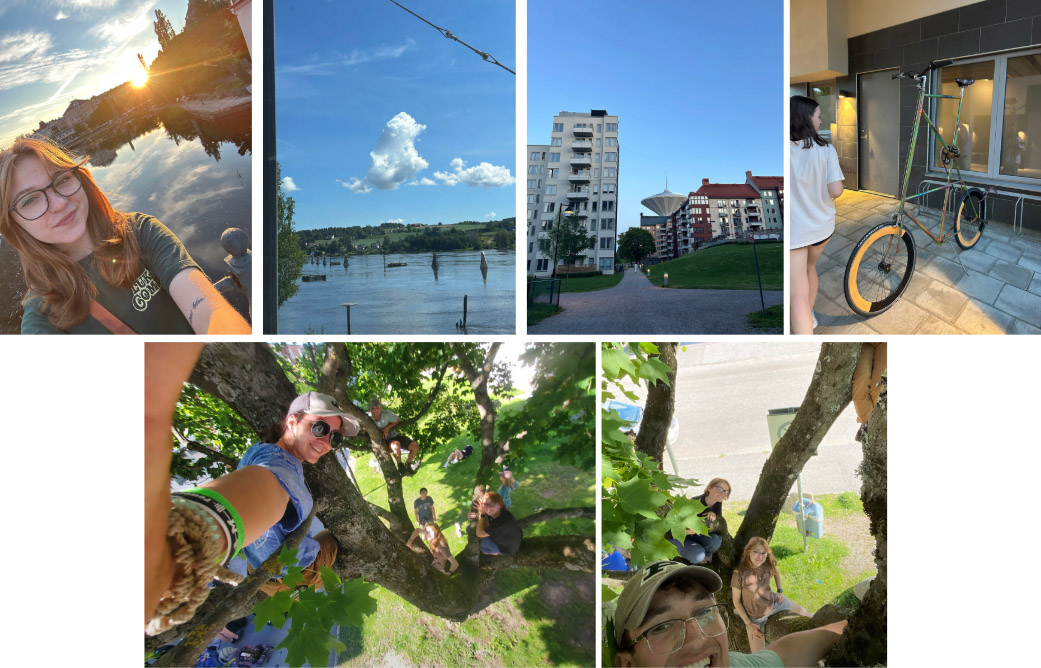 A collage of images from Week 3 of the Sweden Study Abroad trip, including travel from Oslo to Orebro, Norway.
A collage of images from Week 3 of the Sweden Study Abroad trip, including travel from Oslo to Orebro, Norway. Just Some Thoughts ...
Having the opportunity to travel around Sweden and Norway this summer has been an incredible experience. I never thought that I would be able to travel to so many new places, let alone have the opportunity to travel along with my peers and professors!
I’m glad I remembered to bring a good pair of sneakers and hiking boots - I’ve walked at least 10 miles every day of this trip! My feet are definitely tired at the end of the day, but I wouldn't trade this experience for anything.
 A collage of images from Week 2 of the Sweden Study Abroad trip.
A collage of images from Week 2 of the Sweden Study Abroad trip. 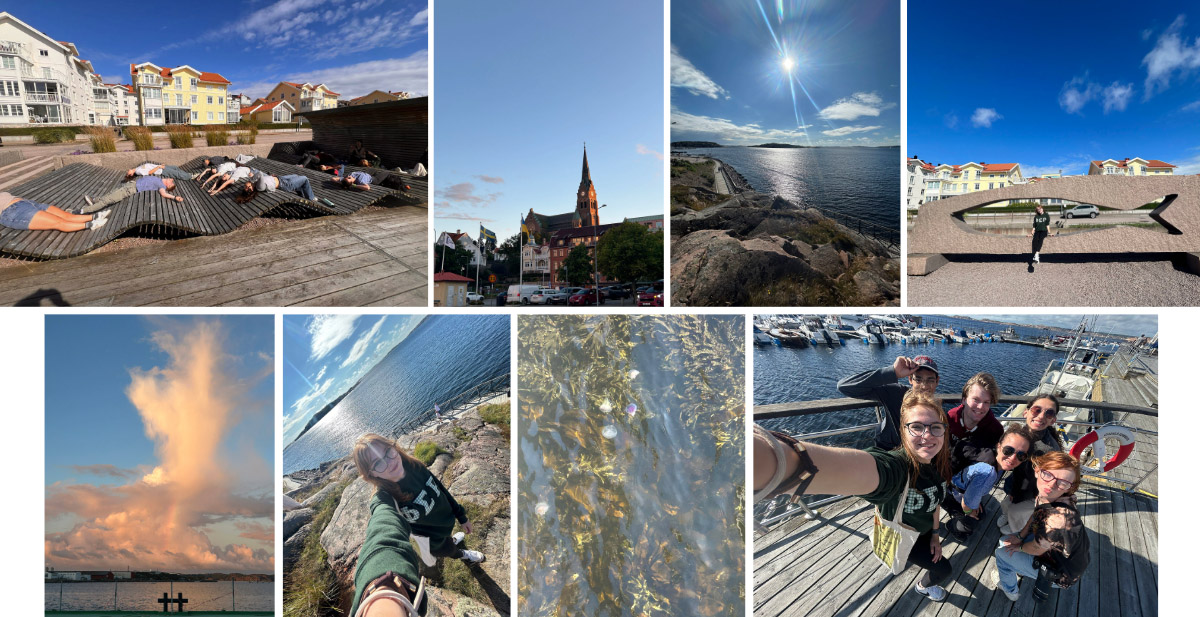 A collage of images from Week 2 of the Sweden Study Abroad trip.
A collage of images from Week 2 of the Sweden Study Abroad trip. 





